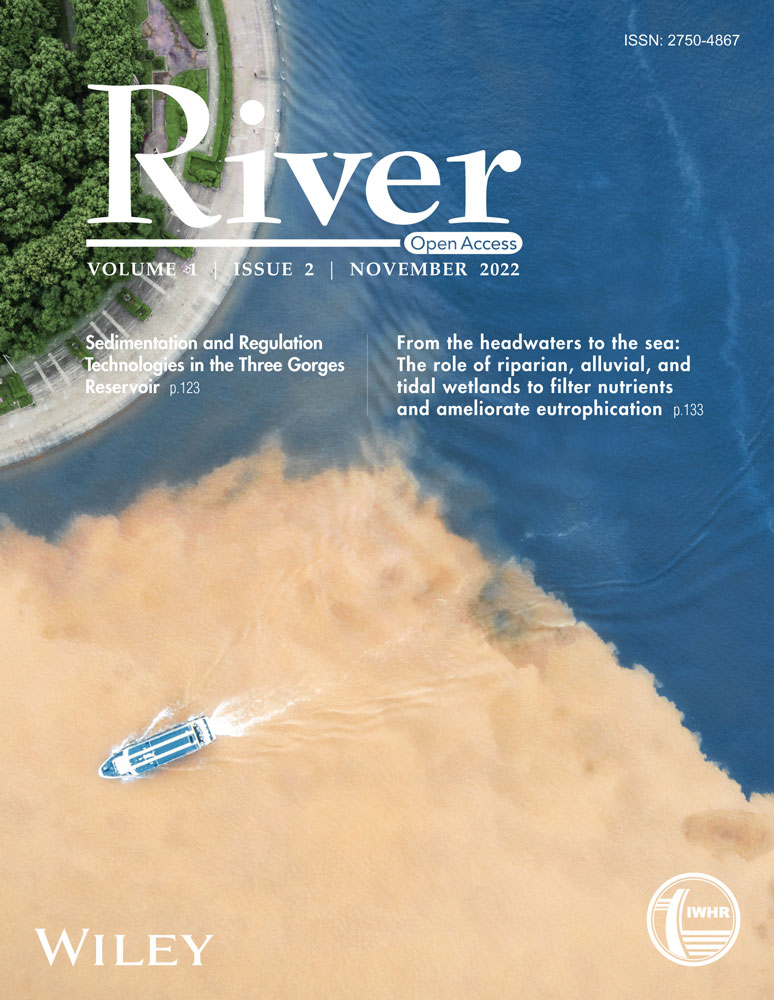The 2022 extreme drought in the Yangtze River Basin: Characteristics, causes and response strategies
Abstract
An extreme drought occurred in the Yangtze River Basin in 2022, inflicting huge impacts nationwide. To provide a reference for drought prevention and mitigation, this paper presents a comprehensive analysis of the drought in the Yangtze River Basin in terms of its characteristics, causes, impacts, and response strategies. It concludes that this extreme drought stood out by its long duration, wide impact range, and severe intensity, as a combined result of abnormal high-temperature weather and massive social water consumption. Serious impacts are observed in various fields of the economy, including agricultural irrigation, urban and rural water supply, power generation, and navigation. Finally, drought mitigation measures and effects are examined, and future drought response and mitigation strategies are proposed.
1 INTRODUCTION
Extreme heat waves have hit many regions of the world since early summer in 2022, with record high temperatures and long duration in many countries. As a combined result of continued high temperatures and little rainfall, droughts have developed rapidly in the midlatitudes of the northern hemisphere and tend to impact widely, linger for long periods, and pose strong intensity. Severe droughts have hit large parts of Africa, Europe, the US, and China. Abnormal global atmospheric circulation and ocean conditions are the main causes of this year's global high temperature and drought. Significant impacts on economies and societies are felt globally. Chronic water scarcity puts stress on our daily life, inducing conflict and competition among water users (Ohlsson, 2000). China is also affected by this wild spread scorching weather. Persistent heat waves and lack of rainfall have caused extreme drought (i.e., megadrought) in the Yangtze River Basin during the flood season (Huo, 2022).
Drought is an insidious, slow-onset natural hazard that produces a complex web of impacts on agriculture, the environment, the economy, and society (Hayes et al., 2011; Ionita et al., 2017; Nam et al., 2015; Song et al., 2016; Wilhite et al., 2007). Compound drought and heatwaves around the world show a tendency of increasing (Bevacqua et al., 2022; Mukherjee & Mishra., 2021). As an important grain production base in China, the Yangtze River Basin feeds about 1/3 of the country's population. Once an extreme drought event occurs, it will have a huge impact on regional and even national social economy, agriculture, production, and other aspects. Therefore, many experts and scholars have carried out research on it. Y. B. Liu et al. (2014) systematically analyzed the causes of frequent extreme drought events in Poyang Lake from 2000 to 2010 and found that precipitation deficit in the basin was the basic drought-causing factor. Jin et al. (2021) analyzed the spatial-temporal variation characteristics of extreme hydrometeorological events in the Yangtze River Basin during 1982–2015. They found that extreme drought events in the Yangtze River Basin showed an overall upward trend, especially after 1998, and the atmospheric extreme drought increased significantly in the upper and lower reaches. Ran et al. (2021) used the GRACE-FO gravity satellite to detect extreme events in the middle and lower reaches of the Yangtze River in 2019, and the results showed that GRACE-FO could better monitor extreme drought events, among which the extreme drought areas were located in eastern Hubei, northern Jiangxi and southern Anhui. In the summer of 2022, an extreme drought hit the Yangtze River basin, posing huge impacts on agriculture, the ecosystem, and human livelihoods. It developed rapidly in the upper, middle, and lower reaches of the Yangtze River, intensifying on a large scale in 10 provinces (municipalities) in the basin (G. N. Chen, 2022; Y. Chen, 2022; Mei, 2022; Zhang, 2022). Governments at the national and local levels have formulated drought-relief plans, guidelines, rules, and regulations, as well as emergency plans. However, whether these measures have been effective to tackle such disasters deserves investigation.
This paper is an early attempt to comprehensively introduce megadrought from a multidimensional perspective. It reviews the development process of the 2022 megadrought in the Yangtze River Basin, discusses its characteristics, causes, and impacts in Sections 3 and 4, with a comparative analysis of historical drought events. Section 5 introduced and examined the specific relief measures in response to the 2022 megadrought event, while Section 6 aims to provide long-term future strategies from a drought comprehensive management perspective.
2 METHODS AND DATA
This paper detects the megadrought event in 2022 from a multidimensional perspective. We analyze the high-temperature days, precipitation distribution, reservoir storage, soil moisture distribution, river inflow, and lake body shrinkage compared with the historically recorded events. Here, high-temperature weather was defined as the daily maximum temperature of no less than 35°C (Xu et al., 2006). Given the long duration of the 2022 drought across the summer flooding season in the Yangtze River Basin, here we regarded the June to August season as the megadrought period, instead of trying to identify the exact time using the index. The drought indices, including precipitation anomalies (PAs), river inflow anomaly, soil moisture deficit, normalized difference water index (NDWI), and so forth, were employed in this study.
NDWI (Mcfeeters, 1996), which is proposed for remote sensing of vegetation liquid water from space, was used to extract water bodies in the Poyang Lake Basin (Xu et al., 2006). NDWI represents the ratio between the difference and summation of green and near-infrared wavelengths, obtained from moderate-resolution imaging spectra radiometers (MODIS; https://modis.gsfc.nasa.gov/) datasets. In general, pixels with NDWI larger than 0 are considered to be water bodies (Xu et al., 2006).
Drought impact data of whole China is statistical by the flood control and drought relief headquarters (FCDRHs) from the 1990s. The FCDRHs include four different levels: State, provincial, municipal, and county (Ma et al., 2020), and this “top to bottom” drought management system gives the possibility to collect the complete drought impact data. The data collected obey the rules of flood and drought disaster reporting guideline, which was released in 2009 and revised in 2018. It includes agricultural drought developing dynamic process statistics, agricultural drought disaster loss statistics, and so forth (Ma et al., 2020). The impact datasets collected provide an effective resource for drought vulnerability assessment and provide validation for hydro-meteorological and agricultural indicators used in risk assessment and monitoring.
The Yangtze River Basin is a typical summer drought-prone area in China where droughts occur frequently. A series of historical droughts occurred in the Yangtze River basin, such as 1785, 1934, 1978, 2006, 2013, and 2019. In this study, we have made an attempt to collect historical drought impact data in the Yangtze River basin for comparison. However, to analyze the typical drought over the last few centuries usually suffer from material deficits (e.g., data missing). Given the impact data collected nationally after the 1990s, thus, we selected the recent three flooding-season droughts (2006, 2013, and 2019) with sufficient data for comparison with the 2022 megadrought.
3 CHARACTERISTICS OF THE 2022 EXTREME DROUGHT IN THE YANGTZE RIVER BASIN
3.1 Characteristics
Prolonged extremely high temperature is the primary characteristic of this drought event. The number of high-temperature days above 35°C is 27.2 on average from July to August 2022 in the Yangtze River Basin, 15.1 days more than the average over the same period from 1991 to 2020 (Figure 1). The heat waves in the Yangtze River Delta, eastern Sichuan, and western Chongqing lingered over 20 days longer than normal. A total of 180 national meteorological stations saw the daily maximum temperatures reach or exceed historical extremes.
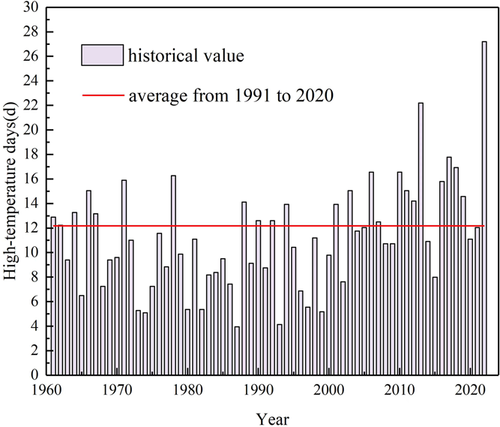
Record lean precipitation is the second characteristic of this extreme drought. The average precipitation in the Yangtze River Basin from July to August was 143.2 mm, 50% less than normal (272.7 mm). By the peak of the drought on August 25th, the cumulative precipitation decreased by 50%–80% relative to the average over the Years 1961–2021. Little rain fell in the basin for over 20 consecutive days within the recent month. In particular, parts of Hunan, Hubei, and Jiangxi exhibited nearly 30 consecutive little-rainfall days, with the precipitation falling short of normal (1961–2021) by over 80%. Figure 2 shows the distribution of precipitation anomaly (PA) in the Yangtze River Basin on July 15th, August 1st, and August 25th. In mid-July, a drought occurred in the middle and lower reaches of the Yangtze River and was mild to moderate in eastern Sichuan and Chongqing, respectively (Figure 2). It then evolved into an almost basin-wide severe drought on August 1st, due to persistent high temperatures and lack of rainfall. On August 25th, the drought situation developed to its gravest stage. Extreme drought hit parts of Chongqing, Hunan, Hubei, and Jiangxi, covering the upper, middle, and lower reaches of the Yangtze River (Figure 2).
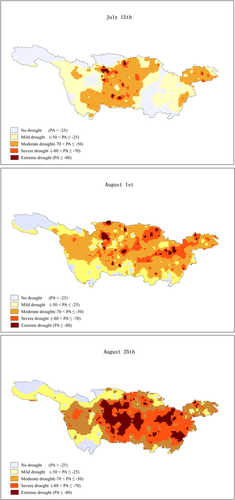
River inflow shrinkage and unprecedented low water levels are also characterized by this drought event. The inflow into the Yangtze River mainstream and tributaries was substantially reduced, notably by 90% at some hydrological stations (e.g., Hankou, Datong, and Jiujiang) to set the lowest records. In early August, the river inflow in parts of Chongqing, Hunan, Hubei, and Jiangxi was 50%–60% less than its historical average (Figure 3). At the peak of the drought on August 25th, the inflow into the Yangtze River mainstream and tributaries further diminished, 50%–70% below normal in parts of Chongqing, Hunan, Hubei, and Jiangxi (Figure 3). The water inflow into Poyang Lake declined dramatically by 60%–80% (Figure 3). Besides, water levels receded to record lows of 5.4 to 7.2 m below normal in the Yangtze River and Poyang Lake.
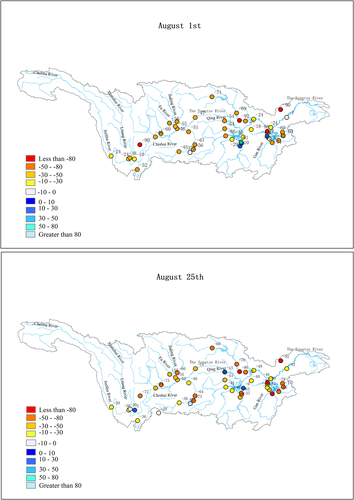
As shown in Figure 4, the water area of Poyang Lake decreased from June to September, rendering the maximum area 3788.12 km2 at the end of July. Due to the severe drought that continued in August, the water area of Poyang Lake decreased sharply by 67.58% from the July level. It dwindled by 58.4% to be 736.68 km2 less than that of the same period in history, setting a new record low in nearly 20 years. As the drought escalated, Poyang Lake saw its water area down from September onwards to 32.4% of its historical average.
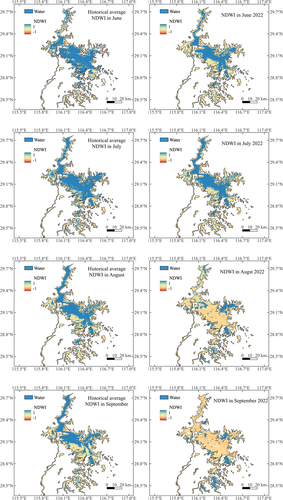
Reservoir storage fluctuated significantly while soil moisture deficit became prominent. Most reservoirs held more water in early August relative to the previous year. For example, water storage of the 1390 large and medium-sized reservoirs in the Yangtze River Basin added by 2.6 billion m3 year on year. As a result of lean precipitation and inflow and huge evapotranspiration in August, the total reservoir storage dropped to 138.8 billion m3 at the end of August 2022, 27.3 billion m3 less than that of the same period last year. To be more specific, the reservoir storage was generally smaller and contracted by 49%, 33%, 28%, and 20% in Jiangsu, Zhejiang, Chongqing, and Hunan respectively. In addition, there was an obvious soil moisture deficit. One-third of the counties in Sichuan, Chongqing, Anhui, Hubei, Hunan, and Jiangxi experienced moderate soil moisture deficit, and one-tenth suffered severe insufficiency.
In short, the 2022 extreme drought in the Yangtze River Basin is characterized by long duration, wide impact range, and strong intensity. It has broken several historical records and produced huge impacts.
3.2 Comparison with historical drought events
Three summer droughts in 2006, 2013, and 2019 of the Yangtze River basin were used to compare with this 2022 megadrought event. They were compared by start time, end time, terminator, duration, affected area, losses, and impacts (Table 1). The 2022 megadrought event has enveloped wide areas, involving 10 provinces along the mainstream and tributaries of the Yangtze River in the upper, middle, and lower reaches (Table 1). This drought has spread very fast and lasted over 4 months to date and is ongoing development (Table 1).
| Year | 2006 | 2013 | 2019 | 2022 |
|---|---|---|---|---|
| Type | Summer drought | Summer drought | Summer and autumn droughts | Summer drought |
| Start time | Mid-May | Early July | Late July | Mid-June |
| End time | Early September | Late August | Late November | Developing |
| Terminator | Autumn rainfall in western China | Typhoon landfall | Winter rainfall | |
| Duration | Nearly 4 months | 50 days | 4 months | 4 months to date |
| Affected area | Upper reaches of the Yangtze River (Chongqing and Sichuan) | Middle and lower reaches of the Yangtze River (Hunan, Hubei, Jiangxi, Anhui, Zhejiang, and Jiangsu) | Middle and lower reaches of the Yangtze River (Hubei, Hunan, Anhui, Jiangxi, Jiangsu, Zhejiang, and Fujian) | Upper, middle, and lower reaches of the Yangtze River, covering most provinces in the Yangtze River Basin (Sichuan, Chongqing, Guizhou, Hunan, Hubei, Jiangxi, Anhui, Jiangsu, Shanxi, and Henan) |
| Impacts | 3,776,000 ha of cropland affected, 8.2 million people in Chongqing and 7.17 million people in Sichuan experiencing difficulties accessing drinking water; direct economic loss of 9.12 billion yuan in Chongqing; direct agricultural loss of 8.06 billion yuan, and industrial loss of 7 billion yuan in Sichuan. | 4,782,667 ha of cropland were affected, and 6.11 million people experienced difficulties accessing drinking water at the peak of the drought. | 1,717,333 ha of cropland affected in Hunan, Hubei, Chongqing, and Jiangxi. 370,000 people and 110,000 bigger-sized livestock experiencing difficulties accessing drinking water at the peak of the drought | 4,421,333 ha of cropland were affected in the Yangtze River Basin, and 4.99 million people and 920,000 bigger-sized livestock experienced difficulties accessing drinking water at the peak of the drought |
4 CAUSES AND IMPACTS OF THE 2022 EXTREME DROUGHT IN THE YANGTZE RIVER BASIN
4.1 Causes
The 2022 extreme drought is a combined result of natural and social factors. In terms of natural factors, the larger-than-usual subtropical high is the direct cause of the drought. In the summer of 2022, the western Pacific subtropical high was significantly stronger than normal and covered a wider range of areas after merging with the continental high. Especially as the broad high-pressure system enveloped the Yangtze River Basin, the strength of the high-pressure center increased rapidly, leading to the post-1961 record process of high temperatures and low rainfall (Feng et al., 2022; Sun et al., 2022). In terms of social factors, the Yangtze River Basin is the main grain-producing area with water abundance in China. Crop cultivation relies heavily on high-intensity precipitation and irrigation, so water use for agricultural production is relatively large. Once the basin-wide drought occurred in summer and lasted several months, agricultural water use, as predominant water usage, had to be squeezed. On the whole, this extreme drought is attributed to abnormal high-temperature weather and massive social water consumption.
4.2 Impacts
The 2022 megadrought in the Yangtze River Basin has imposed serious impacts on the economy and livelihood, covering farmland irrigation, urban and rural water supply, power generation, and navigation.
First of all, the drought has significantly affected food security. The Yangtze River Basin is the main grain-producing area in China. However, 6 of the 13 major grain-producing provinces in the basin were stricken by the drought that occurred during the key period for crop growth. At the peak of the drought on August 25th, drought-affected cropland area in the Yangtze River Basin reached around 4 million ha.
Second, the drought has stressed urban and rural water supply. Little rainfall coupled with persistent heat waves has led to a water crisis. Some scattered water supply projects that rely on small reservoirs or mountain springs dried up. Water delivery was required in some areas to ensure domestic water use. At the peak of the drought, 4.99 million people and 0.9 million bigger-sized livestock experienced difficulties accessing drinking water. A future challenge for the Yangtze River Basin is whether the existing river and reservoir storage can meet the water demand in the upcoming autumn and winter dry season till the next flood season sets in.
Moreover, spin-offs of the drought included impaired navigation, intensifying saltwater intrusion, squeezing energy production, putting pressure on forest fire protection, and so forth. Due to persistently low water levels, the transport waterways from Anqing to Wuhan and from Wuhan to Yueyang along the Yangtze River were closed in mid-August. The Yangtze estuary was also subject to temporary and mild saltwater intrusion. Electricity load kept mounting in the midst of high temperatures that generally accompany extreme droughts; however, hydropower generation capacity plummeted due to drought, making household electricity use hard to sustain. In Sichuan Province, where hydropower contributed over 80% of all the electricity generation capacity, extensive and prolonged extreme heat waves and droughts halved the power generation by natural water inflow to about 450 GWh from the normal 900 GWh or so. Besides, the continuous 40°C plus weather caused frequent wildfires in Chongqing. More than 10 wildfires broke out in Fuling, Jiangjin, Banan, and other areas, causing the loss of forest resources.
5 DROUGHT MITIGATION MEASURES AND EFFECTS
China has put a drought disaster prevention system in place that combines structural and nonstructural measures, playing an indispensable role in sustaining national economic and social development. The firm actions taken by the Chinese Government to fight and mitigate drought disasters provide a solid support for national food security, drinking water security, and ecological security. The features of the drought response system in China are listed as follows.
There is a strong institutional capacity with unified command and arrangements. Under centralized command, all localities and departments form a joint team for extreme disaster mitigation. The working policy of “people-oriented, law-based drought relief” has been established. A sound regulatory system for drought disaster prevention has taken shape, and the accountability system with the local administrative chiefs assuming prime responsibilities has been established. Communication and cooperation are also highlighted between water conservancy and other sectors, including meteorology, emergency management, and energy. Measures are adapted to local conditions while taking into account overall planning, with respect to the unified planning of river basins or regions. In response to the 2022 extreme drought in the Yangtze River Basin, more than 20 government-led working groups were dispatched to inspect and supervise key affected areas, providing technical support, implementing drought relief measures, and resolving water-use conflicts.
The accelerated construction of major water conservancy projects, critical reservoirs, and large- and medium-sized irrigation districts has reduced the loss caused by droughts and buttressed national water supply security and food security. Backbone water works, such as South-to-North Water Diversion, Yellow River Water Diversion to Tianjin, and water infrastructure focusing on supplying freshwater to suppress saltwater intrusion from the core parts of a national water grid and can guarantee emergency water supply during extreme droughts. To cope with the megadrought in the Yangtze River Basin, water conservancy departments leveraged the Three Gorges Reservoir to supply more than 6 billion cubic meter of water to the middle and lower reaches. The joint operation of water conservancy projects has optimized water resource allocation between left and right banks, between mainstream and tributaries, and between upstream and downstream. Moreover, China has thousands of large and medium-sized irrigation districts, whose annual average yield reaches 1.3 trillion kilograms beyond. They are like the unfailing breadbasket for the Chinese, particularly at times of major droughts. In view of the drought in the Yangtze River Basin, the Ministry of Water Resources instructed over 1900 large- and medium-sized irrigated areas to have plans ready to secure sufficient water supply during the critical period for crop growth. Provinces affected by droughts have all made proper use of small- and medium-sized reservoirs to meet local agricultural water demand.
The management of the megadrought still imposed some problems. We attached importance to "resistance" and ignored "prevention" in terms of concept, so it is difficult to achieve the maximum effect of drought resistance and disaster reduction with minimum investment. In terms of measures, it is difficult to give full play to the maximum drought resistance benefits of engineering facilities by attaching importance to engineering measures and ignoring nonengineering measures. In terms of means, it is difficult to adapt to the requirements of the market economy system by attaching importance to administrative means and ignoring economic, legal, and technological means.
6 SUGGESTIONS FOR FUTURE DROUGHT RESPONSE STRATEGIES
Early action to bolster drought response capacity is the first step to coping with extreme droughts. A comprehensive investigation of water source projects for drought relief nationwide is of fundamental importance, such as the distribution and the types of water sources, water intakes, water transfer pipeline network, and water supply capacity. Furthermore, the joint operation of water conservancy projects and regional water resource allocation projects can be carried out between left and right banks, between mainstream and tributaries, and between upstream and downstream during droughts. Meanwhile, emergency water sources for drought relief should be enhanced, especially in drought-prone areas that are unlikely to be covered by large and medium-sized water projects. Building a number of small reservoirs, water transfer projects, and other drought emergency projects is crucial for augmenting water supply capacity during droughts.
Second, drought risk management as a refined mode of whole-process drought management should be practiced instead of traditional drought crisis management. At present, it is already implemented in some countries (e.g. the USA, Australia, and Canada), thereby providing some successful experiences for our country. More science-based efforts are needed to understand the coverage, duration, and impacts of droughts, thereby providing technical support for drought risk management. At the same time, a comprehensive information system that includes drought forecasting, early warning, and risk assessment should be empowered by next-generation information technologies (e.g., big data and artificial intelligence). It will effectively facilitate prompt and precise decision-making for reducing drought impacts.
Third, drought management should be integrated into an effective legal framework. In 2009, the Drought Relief Regulations were formally promulgated and implemented, filling the gap in drought legislation in China. Nevertheless, it remains imperative to formulate the Drought Prevention and Relief Law in alignment with the profound institutional reform over the last decade, so as to define the responsibilities of relevant departments in drought management within the legal framework. In 2011, the National Drought Relief Plan was approved by the Central government. With the implementation of the plan, the emergency water supply capacity and regional drought relief capacity in drought-prone areas have been effectively improved, which contributes significantly to safeguarding people's livelihood and water supply. A new National Drought Prevention and Control Plan is expected to further enhance comprehensive drought resilience.
In addition, it is important to develop an extreme drought preparedness strategy. To date, China has been able to withstand moderate droughts with the support of large-scale water conservancy construction. However, extreme droughts across basins and regions still pose a major challenge. On the one hand, while placing emphasis on strategic grain reserves, it is advisable to strengthen river management and consolidate and improve irrigation districts to solve water use problems associated with food security. On the other hand, groundwater overabstraction in northern areas should be halted, so that large-scale groundwater storage can be formed for emergency water use during drought. Meanwhile, it is necessary to identify groundwater sources in southern areas and develop water intakes in advance according to the local population and environmental conditions. At the city level, tailored measures should be taken to enhance public awareness of water conservation and drought response strategies.
7 CONCLUSIONS
This paper analyzes the characteristics, causes, and impacts of the 2022 extreme drought in the Yangtze River Basin and provides an overview of this megadrought as a future reference case. The results indicated that the disaster went to the extreme because of abnormally high temperatures and massive social water consumption. Long duration, wide impact range, and strong intensity are the characteristics of this extreme drought event, which has broken several historical records and produced huge impacts. This megadrought event has enveloped wide areas and is still ongoing developed, involving 10 provinces along the mainstream and tributaries of the Yangtze River in the upper, middle, and lower reaches. The Chinese Government adopted a variety of measures in a timely manner to mitigate losses. Unified command and coordination are important in the face of natural disasters. However, drought management still imposes some problems, such as attaching importance to “resistance” and ignoring “prevention,” attaching importance to the engineering measures and ignoring nonengineering measures, attaching importance to administrative means and ignoring economic, legal, and technological means. The focuses and strategies of future drought management in the long term are proposed. Acting early and fast to improve drought response capacity is essential for coping with extreme droughts, and promoting drought risk management under an effective legal framework is also necessary and needed to be fully implemented.
ACKNOWLEDGMENTS
This research was funded by the National Key R&D Program of China (2018YFE0206400, 2021YFC3000202), the National Natural Science Foundation of China (National Natural Science Foundation of China Grant No. 42001039), and the China Institute of Water Resources and Hydropower Research, Research and Development Support Program (JZ110145B0052021, F0203982012).
ETHICS STATEMENT
The author assures that this paper follows the core practices of the Committee on Publication Ethics. The paper has not been published anywhere.
Open Research
DATA AVAILABILITY STATEMENT
The data that support the findings of this study are available from the corresponding author upon reasonable request.



